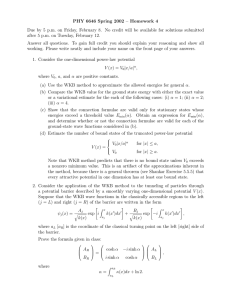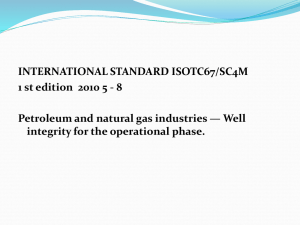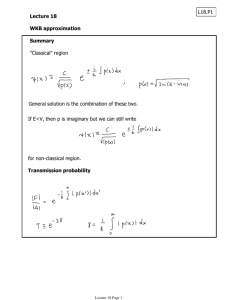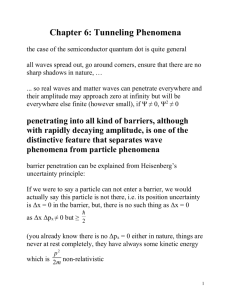Alpha Decay The basics. - Department of Physics, HKU
advertisement
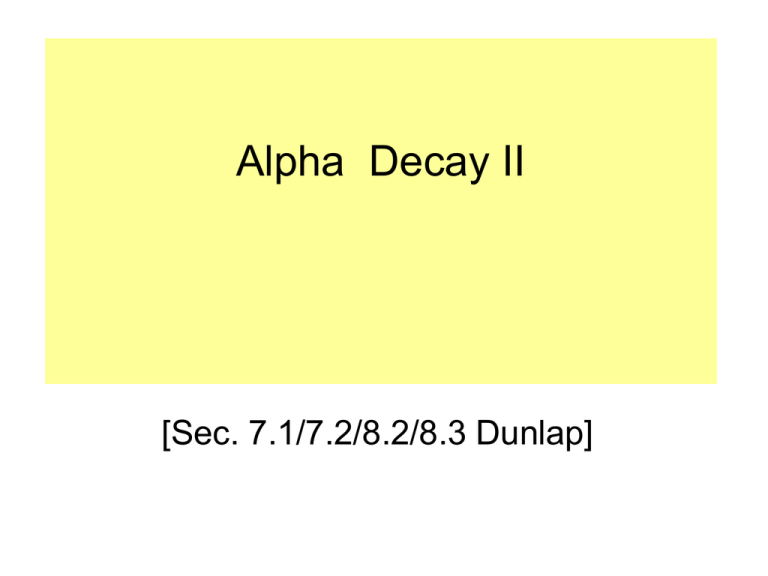
Alpha Decay II [Sec. 7.1/7.2/8.2/8.3 Dunlap] The one-body model of α-decay assumes that the α-particle is preformed in the nucleus, and confined to the nuclear interior by the Coulomb potential barrier. In the classical picture, if the kinetic energy of the -particle is less than the potential energy represented by the barrier height, the α-particle cannot leave the nucleus. vα Qα r=R PT R r=b In the quantum-mechanical picture, however, there is a finite probability that the -particle will tunnel through the barrier and leave the nucleus. The α-decay constant is then a product of the frequency of collisions with the barrier, or ``knocking frequency'‘ (vα/2R), and the barrier penetration probability PT. How high and wide the barrier? 2Ze 2 1 V (r ) 2Z .c. (4 0 )r r The height of the barrier is: Emax 2 Z . .c R The width of the barrier is 30MeV w Lets calculate these for Emax w bR 235 92 U taking R0=1.2F, we have 2 x 92 x197 MeV .F 36 MeV 137 x 7.4 F 2Z . . c R Q R 1.2x(235)1/ 3 7.4F 2x92 x197 MeV .F w 7.4 F 49 F 137 x 4.68 MeV The 1D square potential tunneling problem This problem is quite algebraically difficult to solve exactly (although it can be done) because one has to match the sinusoidal wavefunctions and the gradient of the wavefunction at barrier entry (A) and output (B). The 1D square potential tunneling problem The 3D tunneling problem So taking the case when l=0, we have to solve the 1D SE for the potential The WKB approximation How do we apply this result to the case of the barrier with a height V, that is not constant? As with the finite barrier really exact solution is not possible, but a good approximation exists – it is called the WKB approximation- after physicists (Wentzel, Kramers and Brillouin). The WKB approximation which in the limit of r becoming small becomes: G is known as the Gamow factor. It is this Gamow factor that it is now our task to calculate. The WKB approximation (Q in MeV and R in fm) The WKB approximation The formula for decay rate So finally we have to put everything together to get the decay rate of an alpha unstable nucleus. The decay rate can be considered as a compounding of three probabilities. (i) The probability Pα of the α-particle forming (or being in existence) at a specific time (ii) The probability fα of the α-particle hitting the “wall” of the nucleus each second (iii) The probability T of the α-particle transiting to the “freedom distance” r=b The formula for decay rate where the Gamow factor G can be either expressed by (8.17) or by (1) depending on preference. Explaining the Geiger-Nuttal Law c 2(Q U ) G e P . 2 mc R 1/ 2 0e Z 3.95 Q 2.97( ZR )1/ 2 Where we have ignored the small pre-exponential dependence on Q. We find on taking logarithms 1/ 2 Z ln ln 0 2.97( ZR) 3.95 Q 1/ 2 The range energy relationship for alphas is Nuttal law gives R T3/ 2 so that the Geiger- ln ln Q . The barrier penetration theory gives ln 1/ Q In the range 4<Q<7MeV which covers most alpha emission – a quantity linear in is close to be linear in 1/ Q so that the Geiger Nuttal law is vindicated. ln Q


